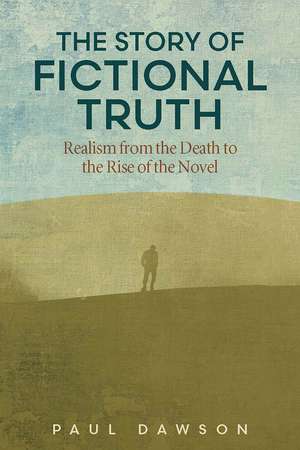The Story of Fictional Truth: Realism from the Death to the Rise of the Novel: Theory and Interpretation of Narrative
Autor Paul Dawsonen Limba Engleză Hardback – 15 feb 2023
Din seria Theory and Interpretation of Narrative
-
 Preț: 314.03 lei
Preț: 314.03 lei -
 Preț: 271.39 lei
Preț: 271.39 lei -
 Preț: 346.23 lei
Preț: 346.23 lei -
 Preț: 305.25 lei
Preț: 305.25 lei -
 Preț: 280.83 lei
Preț: 280.83 lei -
 Preț: 273.46 lei
Preț: 273.46 lei - 23%
 Preț: 473.13 lei
Preț: 473.13 lei - 23%
 Preț: 476.07 lei
Preț: 476.07 lei -
 Preț: 264.26 lei
Preț: 264.26 lei - 19%
 Preț: 588.30 lei
Preț: 588.30 lei - 23%
 Preț: 581.08 lei
Preț: 581.08 lei -
 Preț: 258.88 lei
Preț: 258.88 lei - 23%
 Preț: 479.49 lei
Preț: 479.49 lei - 23%
 Preț: 472.96 lei
Preț: 472.96 lei - 23%
 Preț: 471.20 lei
Preț: 471.20 lei -
 Preț: 314.03 lei
Preț: 314.03 lei -
 Preț: 274.27 lei
Preț: 274.27 lei - 23%
 Preț: 473.13 lei
Preț: 473.13 lei -
 Preț: 517.90 lei
Preț: 517.90 lei
Preț: 444.72 lei
Preț vechi: 577.55 lei
-23% Nou
85.11€ • 88.53$ • 70.26£
Carte tipărită la comandă
Livrare economică 14-28 aprilie
Specificații
ISBN-10: 0814215475
Pagini: 282
Ilustrații: 1 image
Dimensiuni: 152 x 229 x 23 mm
Greutate: 0.45 kg
Editura: Ohio State University Press
Colecția Ohio State University Press
Seria Theory and Interpretation of Narrative
Recenzii
Notă biografică
Paul Dawson is Associate Professor at the University of New South Wales. He is the author of three books, including The Return of the Omniscient Narrator: Authorship and Authority in Twenty-First Century Fiction.
Extras
The theory of reflexive realism, as I will call it, takes shape in the 1980s in the work of scholars such as Michael McKeon (1987) and John Bender (1987), framing the novel as a paradoxical reflection on the artifice of its own mimetic enterprise that emerged in the eighteenth century alongside a new conceptual category of fictionality. This approach to the origins of the realist novel, I contend, was anticipated and made possible by the self-reflexive exposure of fictionality that characterizes postmodern metafiction, prompting scholars to assert that reflexivity is a condition of all fiction. Wenche Ommundsen (1993), for instance, argues that “metafiction is the product of a certain practice of reading, a particular kind of attention brought to bear on the fictional text”. Reflexive realism is the result of this practice of reading brought to bear on the history of the novel: it reads backward from its own historical moment to recast the origins of the novel in terms legible to contemporary theory, rescuing realism from enforced naïvety by revealing that its emergence depended upon an awareness rather than a suppression of its own fictional status. McKeon (2017), for example, has come to describe formal features of the novel, such as narratorial intrusions and Free Indirect Discourse (FID), as “expressions of realist reflexivity”. In this light, the narrative methods of “formal realism” established in this self-consciously new species of writing can be seen as embedded signposts of fictionality carrying a latent challenge to their own promise of representational correspondence. The historical logic of such a premise is that the novel proleptically establishes the conditions for its own death, the moment at which the paradox of realism can no longer be sustained, and is stripped bare by postmodern artifice. The trope of the death of the novel that shapes metafictional responses to the exhaustion of realism thus provides the impetus not only for reconsidering the origins of the form but for revealing that its origins lie in its own end point.
Cuprins
Introduction Literary History and the Theory of Reflexive Realism
Chapter 1 From Digressions to Intrusions: The Historical Paradox of Authorial Commentary
Chapter 2 Against Sympathy: The Self-Examining Heroine and the Origins of Free Indirect Discourse
Chapter 3 Interiority and the End of Consciousness: From the Conduct Scene to the Sex Scene
Chapter 4 Dying to Tell About It: The Autothanatographic Impulse of First-Person Narration
Chapter 5 Beyond the Threshold: Accounting for the Self as Other
Conclusion The Exhaustion of Fictionality: Metamodernism and the (Auto)Fictional Pact
Descriere
In The Story of Fictional Truth, Paul Dawson looks anew at the historical relationship between the genre of the novel and the concept of fictionality, arguing that existing scholarship on the emergence of realist fiction has been shaped by the trope of the death of the novel. The unexplored logic of this premise is that the novel was born anticipating its own demise, with both its requiem and its reflexive origins legible in the ontological challenge of postmodern metafiction. To test this logic, Dawson traces shifting assumptions about what constitutes the illusion of fictional truth from early novels such as The History of Miss Betsy Thoughtless (1751) to contemporary autofiction such as Megan Boyle’s Liveblog (2018). In doing so, he contests and revises long-held views about the origins and functions of key formal features of the realist novel by investigating when and how they came to be seen as signposts of fictionality. Through this history, The Story of Fictional Truth opens up new ways to understand the novel’s afterlife in a post-truth digital age characterized by a collapse of referentiality.
